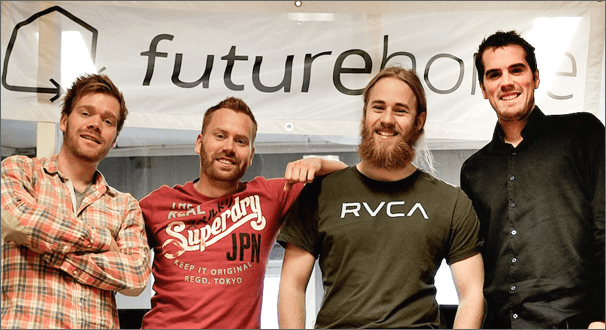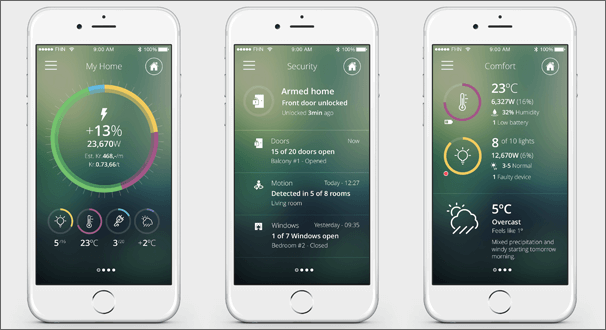Futurehome: The home automation technology that’s taking Norway by storm
Futurehome: The home automation technology that’s taking Norway by storm
Odd Eivind Evensen is the development manager for Futurehome, a start-up company based in Stavanger, Norway that uses crowd funding and IoT to revolutionise the way we interact with our household appliances.
As part of our commitment to supporting innovative hardware start-ups with product development, Premier Farnell was able to offer a one-stop solution to Futurehome for all areas of product development, through our subsidiaries Avid.
We spoke to Eivind about the development of the Futurehome project; their plans for the future and how collaborating with Premier Farnell helped them to turn their vision into a reality.

In a nutshell, what is Futurehome?
Futurehome is a Smart Home system that allows you to control, automate and monitor your home from wherever you are in the world via a simple app. This can help you to save time by centralising control of your household appliances, to improve your security and to reduce the cost of household bills by offering greater visibility of your energy consumption, particularly electricity.
While other Smart Home systems have been marketed in the past, very few people currently have access to them, due to the fact that they tend to be quite expensive and time consuming to install. At Futurehome we focus on offering completely wireless solutions, which require much less maintenance and are considerably easier to install, delivering a complete package for the end user, technician and distributor.
How did you come to be involved with the Futurehome project?
I’ve always been interested in technology, particularly electronics and telecommunications. In 2012 was studying at the University of Stavanger with my now-colleagues Erik and Bjarne. We shared a passion for software development and we started working on some projects that would allow us to remotely control things like heating, lighting, alarms and multimedia.
At the time Erik was working for a company called Bravida, which is the largest electrical installer in Norway. They gave us the opportunity to showcase the project at an expo event, and the feedback we received after doing this was positive enough to convince us that there was a genuine demand out there for simple, inexpensive smart home systems. So the three of us decided to try to take our hobby to the next level and turn it into a business.
How important has crowd funding been to the Futurehome project?
Crowd funding has been hugely important to the development of Futurehome. Without it, we would have found it much more difficult to initiate production and to offer the Futurehome gateway at the lowest possible price. It also helped us to prove to investors not only that we had a great idea, but that there was a clear commercial demand for it.
When we set up our crowd funding campaign in 2014, we decided to set it at a fixed goal, meaning our supporters would recover 100% of their donations if we didn’t reach our target – so it really was all or nothing. We’d already put most of our own savings into the project, and for the 60-day crowd funding period we worked around the clock solely on marketing, getting our names out and selling the project to people wherever we could. It was a huge push and we literally hit our target with hours to spare, but the publicity we received and the contacts we made along the way – combined with the money itself – was enormously beneficial. It was a great project for us.
What role has Premier Farnell and its subsidiaries Avid and Embest Technologies been able to play in the development of Futurehome, and what impact has this had on the project?
For a new start up business, it’s very important to be able to have trust and confidence in your partners. We spoke to several firms about design and manufacturing support in the early days of Futurehome, but we were never particularly happy – either with the quotes, or with the gut feeling we got from talking to them.
When Premier Farnell approached us, we were very impressed by what they were able to offer us – a cost-effective tailored solution that included PCBA design, BoM supply, volume production, compliance, enclosure manufacturing, packaging sourcing and production and full product assembly – all from a single source point.
We were also aware of Premier Farnell’s reputation in the industry and their background in working with start up companies like ours. So far, the experience has only been positive, and like the crowd funding it’s helped to open a lot of doors for us.


At present, Futurehome is only available in Norway. What has the reaction been like on the domestic market?
On the whole the reaction to Futurehome has been very positive. We’ve had a chance to showcase our product at various expos over the past few years, and it’s been interesting to see how the perceptions have changed. In our first year it was a very new concept – many people didn’t understand what a Smart Home was or what it did. Two years later, there’s much greater awareness.
One thing that’s been interesting is the feedback we’ve been getting from electricians and installers, many of whom have installed other Smart Home systems in the past. Because a lot of these older systems were very expensive, temperamental and time consuming to install, a lot of professionals are really attracted to the simplicity and user-friendliness of our model.
The Norwegian start-up scene is extremely healthy at the moment. What is it about your country that makes for such a strong environment for innovation and new business ventures in the tech space?
I think there are a variety of factors at play. The Norwegian government invests heavily in technology, and there’s a lot of support and incentives for people who want to start their own companies. Also due to the way the industrial landscape is changing, a lot of former engineers have started to do things for themselves.
Finally, we have a really strong technology scene, not just in Norway but also in our neighbouring countries like Sweden and Finland. There are a lot of really big expos where tech creators have an opportunity to get together and showcase their work, and I think a lot of really cool initiatives and collaborations have come out of that.
What have been the biggest challenges you’ve faced so far in developing and marketing Futurehome?
Getting the money together is obviously a big challenge from a start-up perspective, which is why crowd funding has been so invaluable to us. It’s not just about developing the product, it’s also about being able to pay our living costs and hire the people we need to take the product further. We’ve also had to be very careful about time management. You can’t take advantage of every opportunity, it’s important to be very decisive about where your energies can be most efficiently focused so that we can continue to develop a great product without getting side-tracked.
What does the future hold for Futurehome?
In the next 12 months we want to have our products available not only in Norway, but also in other European countries including Scandinavia, Germany and the UK. Longer term, we want to take Futurehome all over the world, while continuing to push the product forwards and expand into other exciting areas such as energy harvesting and smart business technology. Hopefully we’ll be able to keep expanding and turning Futurehome into a great place to work.
What other start-ups and emerging technologies are you excited about at the moment?
There are so many. I think a lot of really cool stuff is happening with drones at the moment – which is both exciting and a little bit frightening! I’m also very interested in energy harvesting projects, devices for growing food and smart solutions in general.
What technologies or innovations would you like to see in the IoT space that aren’t currently available?
I’d like to see more movement on standards for hardware and software. At the moment, with electrical standards being what they are, you often have to make several different versions of the same product to make it accessible in different places. It’d be great if that could be addressed.
What advice would you give to somebody who is in the early stages of developing an IoT project and is looking for opportunities to develop it and take it to the market?
Take advantage of open source technologies – they can save you so much time and investment, particularly in the early stages of a project. Find partners and manufacturers that you can trust. As a small company, you’ll seldom get the upper hand if you find yourself bogged down in legal wrangling, so it’s better to have clear, straightforward business relationships that allow you to focus on your core product.
Be prepared for all eventualities, particularly when it comes to finances and unforeseen costs, because they’ll always come. Most importantly, be prepared to put in the hard work. During our first year we were working around the clock and practically living on bread and water. That work is paying off now, but it was an important part of how we got to where we are today.
For more information about how Premier Farnell can help IOT start-ups to develop their projects for the global market, take a look at our Futurehome case study on the element14 community
The Futurehome smart home solution is powered by a Raspberry pi Compute Module, available from Farnell.